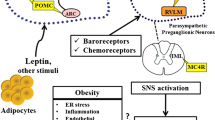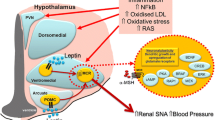Abstract
Hypertension and associated cardiovascular diseases represent the most common health complication of obesity and the leading cause of morbidity and mortality in overweight and obese patients. Emerging evidence suggests a critical role for the central nervous system particularly the brain action of the adipocyte-derived hormone leptin in linking obesity and hypertension. The preserved ability of leptin to cause cardiovascular sympathetic nerve activation despite the resistance to the metabolic actions of the hormone appears essential in this pathological process. This review describes the evidence supporting the neurogenic bases for obesity-associated hypertension with a particular focus on the neuronal and molecular signaling pathways underlying leptin’s effects on sympathetic nerve activity and blood pressure.

Similar content being viewed by others
References
Papers of particular interest, published recently, have been highlighted as: • Of importance •• Of major importance
Garrison RJ et al. Incidence and precursors of hypertension in young adults: the Framingham Offspring Study. Prev Med. 1987;16(2):235–51.
Holecki M, Dulawa J, Chudek J. Resistant hypertension in visceral obesity. Eur J Intern Med. 2012;23(7):643–8.
Fidan-Yaylali G et al. The association between central adiposity and autonomic dysfunction in obesity. Med Princ Pract. 2016;25:442.
Hall JE et al. Obesity-induced hypertension: interaction of neurohumoral and renal mechanisms. Circ Res. 2015;116(6):991–1006.
Esler M et al. Mechanisms of sympathetic activation in obesity-related hypertension. Hypertension. 2006;48(5):787–96.
Neter JE et al. Influence of weight reduction on blood pressure: a meta-analysis of randomized controlled trials. Hypertension. 2003;42(5):878–84.
Lavie CJ, Milani RV, Ventura HO. Obesity and cardiovascular disease: risk factor, paradox, and impact of weight loss. J Am Coll Cardiol. 2009;53(21):1925–32.
Straznicky NE et al. Effects of dietary weight loss on sympathetic activity and cardiac risk factors associated with the metabolic syndrome. J Clin Endocrinol Metab. 2005;90(11):5998–6005.
Fortmann SP, Haskell WL, Wood PD. Effects of weight loss on clinic and ambulatory blood pressure in normotensive men. Am J Cardiol. 1988;62(1):89–93.
Williams IL et al. Endothelial function and weight loss in obese humans. Obes Surg. 2005;15(7):1055–60.
Skinner AC et al. Cardiometabolic risks and severity of obesity in children and young adults. N Engl J Med. 2015;373(14):1307–17. The work reported in this paper demonstrate the close link between obesity, hypertension and other cardiovascular risks in children.
Twig G et al. Body-mass index in 2.3 million adolescents and cardiovascular death in adulthood. N Engl J Med. 2016;374(25):2430–40.
Hubert HB et al. Obesity as an independent risk factor for cardiovascular disease: a 26-year follow-up of participants in the Framingham Heart Study. Circulation. 1983;67(5):968–77.
Kurajoh M et al. Plasma leptin level is associated with cardiac autonomic dysfunction in patients with type 2 diabetes: HSCAA study. Cardiovasc Diabetol. 2015;14:117.
Selvaraj S et al. Association of central adiposity with adverse cardiac mechanics: findings from the hypertension genetic epidemiology network study. Circ Cardiovasc Imaging. 2016;9(6):e004396.
Grassi G, Mark A, Esler M. The sympathetic nervous system alterations in human hypertension. Circ Res. 2015;116(6):976–90.
Alvarez GE et al. Sympathetic neural activation in visceral obesity. Circulation. 2002;106(20):2533–6.
Lambert E et al. Differing pattern of sympathoexcitation in normal-weight and obesity-related hypertension. Hypertension. 2007;50(5):862–8.
Grassi G et al. Sympathetic activation in obese normotensive subjects. Hypertension. 1995;25(4 Pt 1):560–3.
Cooper JN et al. Associations between arterial stiffness and platelet activation in normotensive overweight and obese young adults. Clin Exp Hypertens. 2014;36(3):115–22.
Robinson MR et al. Uncomplicated obesity is associated with abnormal aortic function assessed by cardiovascular magnetic resonance. J Cardiovasc Magn Reson. 2008;10:10.
Masuo K et al. Differences in mechanisms between weight loss-sensitive and -resistant blood pressure reduction in obese subjects. Hypertens Res. 2001;24(4):371–6.
Muntzel MS et al. Cafeteria diet increases fat mass and chronically elevates lumbar sympathetic nerve activity in rats. Hypertension. 2012;60(6):1498–502.
Armitage JA et al. Rapid onset of renal sympathetic nerve activation in rabbits fed a high-fat diet. Hypertension. 2012;60(1):163–71.
Henegar JR et al. Catheter-based radiorefrequency renal denervation lowers blood pressure in obese hypertensive dogs. Am J Hypertens. 2014;27(10):1285–92.
Bhatt DL et al. A controlled trial of renal denervation for resistant hypertension. N Engl J Med. 2014;370(15):1393–401. This study reported the finding from SIMPLICITY-3 trials showing that in patients with resistant hypertension, the effect of renal denervation is similar to sham intervention.
Shibao C et al. Autonomic contribution to blood pressure and metabolism in obesity. Hypertension. 2007;49(1):27–33.
Simonds SE et al. Leptin mediates the increase in blood pressure associated with obesity. Cell. 2014;159(6):1404–16. This paper confirmed the critical role for leptin in mediating obesity-associated hypertension both in humans and animal models.
Aizawa-Abe M et al. Pathophysiological role of leptin in obesity-related hypertension. J Clin Invest. 2000;105(9):1243–52.
Mark AL. Selective leptin resistance revisited. Am J Physiol Regul Integr Comp Physiol. 2013;305(6):R566–81.
Lim K, Burke SL, Head GA. Obesity-related hypertension and the role of insulin and leptin in high-fat-fed rabbits. Hypertension. 2013;61(3):628–34.
Mark AL et al. Contrasting blood pressure effects of obesity in leptin-deficient ob/ob mice and agouti yellow obese mice. J Hypertens. 1999;17(12 Pt 2):1949–53.
Ozata M, Ozdemir IC, Licinio J. Human leptin deficiency caused by a missense mutation: multiple endocrine defects, decreased sympathetic tone, and immune system dysfunction indicate new targets for leptin action, greater central than peripheral resistance to the effects of leptin, and spontaneous correction of leptin-mediated defects. J Clin Endocrinol Metab. 1999;84(10):3686–95.
Minocci A et al. Leptin plasma concentrations are dependent on body fat distribution in obese patients. Int J Obes Relat Metab Disord. 2000;24(9):1139–44.
Van Harmelen V et al. Leptin secretion from subcutaneous and visceral adipose tissue in women. Diabetes. 1998;47(6):913–7.
Cnop M et al. The concurrent accumulation of intra-abdominal and subcutaneous fat explains the association between insulin resistance and plasma leptin concentrations: distinct metabolic effects of two fat compartments. Diabetes. 2002;51(4):1005–15.
Cohen P et al. Selective deletion of leptin receptor in neurons leads to obesity. J Clin Invest. 2001;108(8):1113–21.
van de Wall E et al. Collective and individual functions of leptin receptor modulated neurons controlling metabolism and ingestion. Endocrinology. 2008;149(4):1773–85.
Rahmouni K. Cardiovascular regulation by the arcuate nucleus of the hypothalamus: neurocircuitry and signaling systems. Hypertension. 2016;67(6):1064–71.
Harlan SM et al. Ablation of the leptin receptor in the hypothalamic arcuate nucleus abrogates leptin-induced sympathetic activation. Circ Res. 2011;108(7):808–12.
Rahmouni K, Morgan DA. Hypothalamic arcuate nucleus mediates the sympathetic and arterial pressure responses to leptin. Hypertension. 2007;49(3):647–52.
do Carmo JM et al. Control of blood pressure, appetite, and glucose by leptin in mice lacking leptin receptors in proopiomelanocortin neurons. Hypertension. 2011;57(5):918–26.
Lim K et al. Origin of aberrant blood pressure and sympathetic regulation in diet-induced obesity. Hypertension. 2016;68(2):491–500. This paper investigates the role of various hypothalamic regions in mediating leptin’s contribution to obesity-associated hypertension.
Marsh AJ et al. Cardiovascular responses evoked by leptin acting on neurons in the ventromedial and dorsomedial hypothalamus. Hypertension. 2003;42(4):488–93.
Shih CD, Au LC, Chan JY. Differential role of leptin receptors at the hypothalamic paraventricular nucleus in tonic regulation of food intake and cardiovascular functions. J Biomed Sci. 2003;10(4):367–78.
Mark AL et al. Leptin signaling in the nucleus tractus solitarii increases sympathetic nerve activity to the kidney. Hypertension. 2009;53(2):375–80.
Smith PM, Ferguson AV. Cardiovascular actions of leptin in the subfornical organ are abolished by diet-induced obesity. J Neuroendocrinol. 2012;24(3):504–10.
Young CN et al. The brain subfornical organ mediates leptin-induced increases in renal sympathetic activity but not its metabolic effects. Hypertension. 2013;61(3):737–44.
Farooqi IS et al. Clinical spectrum of obesity and mutations in the melanocortin 4 receptor gene. N Engl J Med. 2003;348(12):1085–95.
Greenfield JR et al. Modulation of blood pressure by central melanocortinergic pathways. N Engl J Med. 2009;360(1):44–52.
Tallam LS et al. Melanocortin-4 receptor-deficient mice are not hypertensive or salt-sensitive despite obesity, hyperinsulinemia, and hyperleptinemia. Hypertension. 2005;46(2):326–32.
Rahmouni K et al. Role of melanocortin-4 receptors in mediating renal sympathoactivation to leptin and insulin. J Neurosci. 2003;23(14):5998–6004.
Bates SH et al. STAT3 signalling is required for leptin regulation of energy balance but not reproduction. Nature. 2003;421(6925):856–9.
Gao Q et al. Disruption of neural signal transducer and activator of transcription 3 causes obesity, diabetes, infertility, and thermal dysregulation. Proc Natl Acad Sci U S A. 2004;101(13):4661–6.
Harlan SM et al. Cardiovascular and sympathetic effects of disrupting tyrosine 985 of the leptin receptor. Hypertension. 2011;57(3):627–32.
Dubinion JH et al. Role of proopiomelanocortin neuron STAT3 in regulating arterial pressure and mediating the chronic effects of leptin. Hypertension. 2013;61(5):1066–74. This paper demonstrates a critical role for STAT3 signaling in POMC neurons in mediating both the metabolic and cardiovascular sympathetic effects of leptin.
Munzberg H, Flier JS, Bjorbaek C. Region-specific leptin resistance within the hypothalamus of diet-induced obese mice. Endocrinology. 2004;145(11):4880–9.
Patterson CM et al. Leptin action via LepR-b Tyr1077 contributes to the control of energy balance and female reproduction. Mol Metab. 2012;1(1–2):61–9.
Cota D et al. Hypothalamic mTOR signaling regulates food intake. Science. 2006;312(5775):927–30.
Mori H et al. Critical role for hypothalamic mTOR activity in energy balance. Cell Metab. 2009;9(4):362–74.
Harlan SM et al. Hypothalamic mTORC1 signaling controls sympathetic nerve activity and arterial pressure and mediates leptin effects. Cell Metab. 2013;17(4):599–606. This is the first report to implicate hypothalamic mTORC1 in sympathetic and cardiovascular regulation.
Harlan SM, Rahmouni K. PI3K signaling: a key pathway in the control of sympathetic traffic and arterial pressure by leptin. Mol Metab. 2013;2(2):69–73.
Rahmouni K et al. Hypothalamic ERK mediates the anorectic and thermogenic sympathetic effects of leptin. Diabetes. 2009;58(3):536–42.
Do Carmo JM et al. Shp2 signaling in POMC neurons is important for leptin’s actions on blood pressure, energy balance, and glucose regulation. Am J Physiol Regul Integr Comp Physiol. 2014;307(12):R1438–47.
do Carmo JM et al. Role of Shp2 in forebrain neurons in regulating metabolic and cardiovascular functions and responses to leptin. Int J Obes (Lond). 2014;38(6):775–83.
Bjorbaek C et al. Identification of SOCS-3 as a potential mediator of central leptin resistance. Mol Cell. 1998;1(4):619–25.
Pedroso JA et al. Inactivation of SOCS3 in leptin receptor-expressing cells protects mice from diet-induced insulin resistance but does not prevent obesity. Mol Metab. 2014;3(6):608–18.
Bence KK et al. Neuronal PTP1B regulates body weight, adiposity and leptin action. Nat Med. 2006;12(8):917–24.
Belin de Chantemele EJ et al. Protein tyrosine phosphatase 1B, a major regulator of leptin-mediated control of cardiovascular function. Circulation. 2009;120(9):753–63.
Bruder-Nascimento T et al. Deletion of protein tyrosine phosphatase 1b in proopiomelanocortin neurons reduces neurogenic control of blood pressure and protects mice from leptin- and sympatho-mediated hypertension. Pharmacol Res. 2015;102:235–44.
Author information
Authors and Affiliations
Corresponding author
Ethics declarations
Conflict of Interest
Balyssa B. Bell and Kamal Rahmouni declare that they have no conflict of interest.
Human and Animal Rights and Informed Consent
This article does not contain any studies with human or animal subjects performed by any of the authors.
Sources of Funding
The authors’ research is supported by the US National Institutes of Health (HL084207), the American Heart Association (Award #14EIA18860041), the University of Iowa Fraternal Order of Eagles Diabetes Research Center, and the University of Iowa Center for Hypertension Research.
Additional information
This article is part of the Topical Collection on Metabolism
Rights and permissions
About this article
Cite this article
Bell, B.B., Rahmouni, K. Leptin as a Mediator of Obesity-Induced Hypertension. Curr Obes Rep 5, 397–404 (2016). https://doi.org/10.1007/s13679-016-0231-x
Published:
Issue Date:
DOI: https://doi.org/10.1007/s13679-016-0231-x




